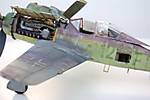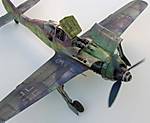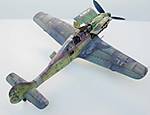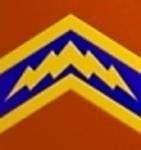1⁄35Fw 190D-9 Part 1
11
Comments
WE ALL WERE A "BEGINNER" AT SOME POINT
I especially hope to reach the beginning modelers who peruse this site. As I feel that a lot of the WIP articles I read on the internet are sometimes addressed to the more advanced modelers and thus leave out a lot of important information that a beginner would want to know in order to understand the writer's comments. And to be perfectly candid, as I think of that preceding point, I am not sure that experienced aircraft modelers would find anything about my article that would be informative to them.I feel a sense of loyalty toward the novice, the beginner. And I will explain that point below. I feel the need for writing to that particular beginning group of modelers, using a very simple and basic style of writing that even the novice can understand without difficulty. The following is an example of what I'm taking about and it will seem silly to experienced modelers: Many forum posts and articles speaking about applying decals to an aircraft simply write something similiar to the phrase, " just Futured it and sprayed the dull coat". Well, to an experienced modeler, particularly in the USA, they all know what that means. But to a lot of some beginners, they do not know that Future refers to a clear acrylic liquid floor wax manufactured by Johnson and Johnson in the USA. A lot of beginning modelers who search the internet do not know what the term "Future" means. And thus I feel that experienced modelers will find my writing style boring and tedious and will move on to something else. But that is OK.
I feel the stong need to reach beginners for a number of reasons. For one, the novice builders in our hobby are the ones who need nurturing, to be shown the way to a higher skill level. I also see the economic aspect of this nurturing process. We need a constant supply of interested girls and boys, women and men, of all ages, to become modelers and the purchasers of new kits, to keep our hobby healthy and growing. We can not do a good job of reaching these beginners by writing... "just Future it and spray on the dull coat."
PAY IT FORWARD
Like some modelers, I had a mentor. He was both a gentleman and great friend. He made the time to sit next to me at my hobby table and showed me how to improve. I met him through our local IPMS chapter. (I would recommend that if you have a model club nearby, and you aren't currently involved, that you become a regular and interact with other modelers. In terms of improving as a modelbuilder, a local club can be a great asset.) My mentor's name was Dick Clay. Unfortunately, because of complications as a result of diabetes, he died when he was just 52 years old. I have never forgotten how willing he was to be there to explain and demonstrate in a step by step, very basic manner, how to develop the discipline to become a better modeler. He explained that it is ALL about discipline, not some secret technique. And he would be available to anyone who asked. Besides that, and more importantly, Dick Clay was a wonderful human being. He cared about people and was a friend to all he met. A role model and a person of class, integrity and character. I cherish his memory, and try to share all that he stood for and believed in, by the way I treat others. After his death, I saw a movie about "Pay it Forward", which dealt with taking what someone taught you and passing it on to the younger generations. I immediately thought of my departed friend, Dick Clay. So here I am, writing this article and trying to "Pay it forward". In my mind, this article is NOT about me, or the model I built, or any of that. It's about how the information I pass on will hopefully, be of benefit to YOU, so that you can start to become the modeler that you want to be. Over the years I have started to understand the idea that modeling is uniquely connected to so many, many other wonderful things, or aspects of life.TWO TYPES OF MODEL BUILDERS
Type One: Is the type that I was for my beginning years, at age 28. (There were no plastic models when I was a boy during WWII.) And Whoa Nellie... Was that period a lot of fun! I put models together just for the sheer joy of working with my hands. I usually completed a model in a few days. Airbrush? I don't think so. Paint the plastic? Nada! And of course, there is nothing wrong with building models in that way. The most important thing, is that a modeler should enjoy what they are doing, whether they put a kit together in an afternoon, or whether they decide to spend four months, or even four years putting it together. It should be fun!Type Two: Is the gal or guy who sees model building not as a sprint but as a marathon. They see this hobby as having so many fascinating aspects to it, how building models can introduce a person to the study of history, making themselves more aware of the various modeling subjects' historical period. And, with good references, they can make more historically accurate models. They can also come to understand how model building can become a life long search for improvement and a desire to learn all they can, in an attempt to make their modeling skills develop and improve. I believe there is a chance that most modelers can develop the discipline to stay the course. To learn how to scratch-build a part again and again until they get it right. To be willing to experiment and try different styles, different approaches, in an attempt to expand their abilities. They should also be willing to risk failure, and use the failed attempt as a means to grow in knowledge from the mistake... and thus become that much better because of their courage to leave their comfort zone and take a risk. Like life itself, model building has a great deal to offer. In this article on building the old 1:32nd scale Revell Dora, it is this second group of modelers that I want to address. My intention is to speak to those who want to grow in skill as modelers. Although, for some, this more disciplined approach would not be fun and believe me, I know from my own experience. So if you're in that first group of modelers, and decide to quit reading, that is OK. I understand, for I started there at age 28, so I've been there, done that, and bought the T-shirt!
AMS is the abbreviation for Advanced Modelers Syndrome. This term describes a modeler that becomes so caught up in trying to make a perfect model - with a lot of modifications and/or a lot of added resin parts, or a fair amount of scratchbuilding - that the fear of failure starts to develop in her or his mind. This fear of messing up, causes them to put the unfinished model aside, close the box and move on to another project. Many modelers who consider themselves serious modelers, who are trying to grow and improve, have had, or now have symptoms of AMS. I have had that same malady myself, and more than once. Thus I have a whole closet full of boxes of unfinished kits. My point is, I think that we need to keep it fun! If we're trying too hard to reach a certain skill level before we have developed the discipline for that level ‹ meaning we're not comfortable with that skill level yet and not enjoying it - then AMS can occur. It has taken me many years to develop the discipline to slow down, take care with each sub-assembly, to get it right, each step of the way, deciding to build a few models the best I can, and not be concerned about building as many as I can. Is there anything wrong with building as many as you can, a collection of a particular period, or aircraft manufacturer, etc.? Of course, not. As long as you're having fun.
Comments
Hi Rudi and Rowan:
@Rudi: Thanks for the kind remarks, my friend. Most appreciated. Hope
you had a chance to look at Steve's fine article on the Eduard boxing
of the Fok. DVII's. Very comprehensive and informative, plus great
pictures as well.
@Rowan: Sorry I haven't replied to your most welcomed email, Rowan.
Been real sick since last Thurs. and still quite weak. But I wanted to let
you know how pleased I am with the way you used the pictures and the
way you did the article layout. Part II is almost completed, only one more
colored pencil sketch to do and it will be on the way. Again, thank you.
Miami Jayhawk
OCT 01, 2006 - 04:47 PM
Hi Rick!
Thanks for writing a feature about such an interesting build! I can't wait to see part 2! And take care of yourself...
Jean-Luc
OCT 01, 2006 - 05:02 PM
Hello Jean-Luc:
It was so nice to read your remarks. And thanks for taking time to do so.
And let me take this opportunity to say thank you to you as well, Jean-Luc
for all the time you donate to Aeroscale as Associate Editor. I've enjoyed
and appreciated your posts and your reviews, articles. As model builders,
we are fortunate to have people like Rowan and you working hard to
make this site a place of solid and yet interesting information.
OCT 02, 2006 - 06:46 PM
Hi Rick
Sorry to read that you've been unwell - I really hope you're back on the way to feeling 100% again. Editing your article was both a delight and highly instructive - it's packed with good-sense advice for modellers at every level and it certainly had me re-evaluating my own outlook! I can't wait to see the future installments - that sort of weathered paint-job is something I really want to read more about...
All the best
Rowan
OCT 02, 2006 - 07:37 PM
Thanks Rowan for your response.
Most appreciated, my friend. A word about the fact that I painted and
weathered this model in such extreme measures: From reading and from
research, I knew that the Fw 190 D-9 near the end of the war, in many cases,
was pressed into service, flying many combat missions, out in the open on the
ground and susceptible to weather conditions etc. with no time for air crews
to do anything other than fill the fuel tanks and re-arm the weapons. . . and get the
aircraft back in the air. Many war time photos show this point to be true. And since
I wanted to learn how to show extreme fading and weathering of paint, I jumped into
this problem with both "small sized number 7" . . . feet. Now, whether this
experiment about weathering was successful or not? Well. . . I suggest
you read the other parts of the article. I'll go into detail about spraying on my
own aircraft markings with hand made templates, instead of using decals,
in the future parts of the article.
OCT 04, 2006 - 12:59 AM
Greetings Rick and all;
While I love a good challenge I have to doff my chapuea to the common sense attitude of the author, Rick Brownlee. I tend to go for detail but nothing repeat nothing beats basics, basics, basics. The most basic tenant of modeling is having fun. No matter what it is just a hobby and a model is just a model. There are well built highly detail builds but as Rick tells us we all started somewhere.
In a recent experience on a another general modeling website I have seen almost a coyote pack mentality. Here the average modeler gets a chance to grow like a local modeling club. Everyone is encouraged to participate and learn something. Thanks Rick. Model On!
OCT 04, 2006 - 05:49 AM
Greetings Jack Flash:
Hello Steve. I sincerely appreciate your comments about my article on
building the old Revell 1:32nd FW 190 D. It was gratifying to me that,
although you're a highly skilled modeler of much experience, you still
found something of interest to you in what I am writing. The thrust and
style of my "musings" is more aimed toward the beginners, but I was
hoping there might be something of value in the Part One, to modelers at
all experience levels.
Thanks again! The encouragement will help me to work with even
more enthusiasm, on the other parts of the article.
OCT 04, 2006 - 05:10 PM
I have to say that this is probably the best article Ive seen since I joined Aeroscale.
Congratulations on a fine piece of work Rick.Looking forward to the next instalment and get well soon.
Nige
OCT 04, 2006 - 09:31 PM
"Outstanding" is a word that comes to mind reading the article......
But, on the other hand, that is something that I have grown accustomed to reading articles and seeing the finished projects on these forums...
Keep it up lads!



OCT 04, 2006 - 09:43 PM
To Nigel Julian and Jan Bojarp:
@Nigel: I really appreciate your most gracious remarks, Nigel. Most
gratifying considering the amount of work in preparing a series like this.
My first try at more than a "one part article". Thanks again.
@Jan, a.k.a. Lucky 13: Oh my Jan, I guess a week from
today (Friday) you'll be in "thirteen-ers heaven"? Eh? Thanks
for taking the time to respond, in such a positive way. As you know,
most of us only comment when there is something wrong.
We kind of become the "silent majority" when it is
something we like. And you're right! The Big A is a great site and
demonstrates so emphatically the benefits of "effective communication".
OCT 05, 2006 - 03:57 PM
Copyright ©2021 by Rick Brownlee. Images also by copyright holder unless otherwise noted. The views and opinions expressed herein are solely the views and opinions of the authors and/or contributors to this Web site and do not necessarily represent the views and/or opinions of AeroScale, KitMaker Network, or Silver Star Enterrpises. Images also by copyright holder unless otherwise noted. Opinions expressed are those of the author(s) and not necessarily those of AeroScale. All rights reserved. Originally published on: 2006-10-01 00:00:00. Unique Reads: 8725





















